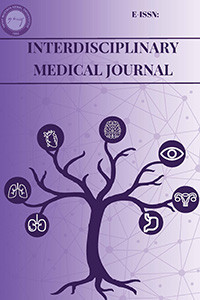Surveillance of urine cultures and evaluation gram negative uropathogens;five year data from Erbil
Surveillance of urine cultures and evaluation gram negative uropathogens;five year data from Erbil
Urine Culture, Urinary Tract Infections, Antimicrobial Resistance, Antimicrobial Resistance,
___
- Köves B, Cai T, Veeratterapillay R, Pickard R, Seisen T, Lam TB, Yuan CY, Bruyere F, Wagenlehner F, Barto-letti R, Geerlings SE, Pilatz A, Pradere B, Hofmann F, Bonkat G, Wullt B. Benefits and Harms of Treatment of Asymptomatic Bacteriuria: A Systematic Review and Meta-analysis by the European Association of Urology Urological Infection Guidelines Panel. Eur Urol. 2017;72(6):865-868. https://doi.org/10.1016/j.eururo.2017.07.014.
- Anderson GG, Goller CC, Justice S, Hultgren SJ, Seed PC. Polysaccharide capsule and sialic acid-mediated regulation promote biofilm-like intracellular bacterial communities during cystitis. Infect Immun. 2010;78(3):963-975. https://doi.org/10.1128/IAI.00925-09
- Beyer AK, Currea GCC, Holm A. Validity of microscopy for diagnosing urinary tract infection in general practice - a systematic review. Scand J Prim Health Care. 2019;37(3):373-379. https://doi.org/10.1080/02813432.2019.1639935
- Flores-Mireles AL, Walker JN, Caparon M, Hultgren SJ. Urinary tract infections: epidemiology, mecha-nisms of infection and treatment options. Nat Rev Microbiol. 2015;13(5):269-284. https://doi.org/10.1038/nrmicro3432
- Ganguly N, Wattal C, Chandy S, Arora S, Gupta U, and Kotwani A. Situation Analysis Antibiotic Use and Resistance in India. Public Health Foundation of India and Center for Disease Dynamics, Economics and Policy. 2011;209-212.
- Scholes D, Hooton TM, Roberts PL, Stapleton AE, Gupta K, Stamm WE. Risk factors for recurrent urinary tract infection in young women. J Infect Dis. 2000;182(4):1177-82. https://doi.org/10.1086/315827.
- Walsh T and Collyns T. The pathophysiology of urinary tract infections. Surgery (Oxford), 2017;35(6):293-298. https://doi.org/10.1016/J.MPSUR.2017.03.007
- Oteo J, Pérez-Vázquez M, Campos J. Extended-spectrum [beta]-lactamase producing Escherichia coli: changing epidemiology and clinical impact. Curr Opin Infect Dis. 2010;23(4):320-6. https://doi.org/10.1097/qco.0b013e3283398dc1.
- Martens E, Demain AL. The antibiotic resistance crisis, with a focus on the United States. J Antibiot. 2017 May;70(5):520-526. https://doi.org/10.1038/ja.2017.30.
- Hooton TM. Clinical practice. Uncomplicated urinary tract infection. N Engl J Med. 2012;15;366(11):1028-37. https://doi.org/10.1056/NEJMcp1104429.
- Ahmed SS, Shariq A, Alsalloom AA, Babikir IH, Alhomoud BN. Uropathogens and their antimicrobial re-sistance patterns: Relationship with urinary tract infections. Int J Health Sci. 2019;13(2):48-55.
- Aktaş O, Denktaş E. Five- Year Evaluation of the Urine Culture Results and Antimicrobial Susceptibility Profiles of Isolated E. coli Strains. Biomed J Sci & Tech Res. 2020; 24(2). https://doi.org/10.26717/BJSTR.2020.24.004029
- Giwa FJ, Ige OT, Haruna DM, Yaqub Y, Lamido TZ, Usman SY. Extended-Spectrum beta-lactamase pro-duction and antimicrobial susceptibility pattern of uropathogens in a Tertiary Hospital in Northwestern Nigeria. Ann Trop Pathol 2018;9:11-6 https://doi.org/10.4103/atp.atp_39_17
- Gupta N, Kundra S, Sharma A, Gautam V, Arora DR. Antimicrobial susceptibility of uropathogens in In-dia. J Infect Dis Antimicrob Agents. 2007;24:13-18.
- Osman AA. Antibiotic Resistance of Bacteria isolated in Urinary Tract Infections in Erbil City. Zanco J of Pure and Applied Sci. 2019; 31(4):42-49. https://doi.org/10.21271/zjpas.31.4.5
- Abujnah AA, Zorgani A, Sabri MA, El-Mohammady H, Khalek RA, Ghenghesh KS. Multidrug resistance and extended-spectrum β-lactamases genes among Escherichia coli from patients with urinary tract in-fections in Northwestern Libya. Libyan J Med. 2015;2;10:26412. https://doi.org/10.3402/ljm.v10.26412.
- Ali FA, Merza EM and Aula TS. Antibiotic resistance among Escherichia coli isolated from different clinical samples in Erbil City. Int J of Research Studies in Sci, Eng and Tech. 2017;4(10):12-21.
- Edlin RS, Shapiro DJ, Hersh AL, Copp HL. Antibiotic resistance patterns of outpatient pediatric urinary tract infections. J Urol. 2013;190(1):222-7. https://doi.org/10.1016/j.juro.2013.01.069.
- Mohammed MA, Alnour TM, Shakurfo OM, Aburass MM. Prevalence and antimicrobial resistance pattern of bacterial strains isolated from patients with urinary tract infection in Messalata Central Hospi-tal, Libya. Asian Pac J Trop Med. 2016;9(8):771-6. https://doi.org/10.1016/j.apjtm.2016.06.011.
- Hertz FB, Schønning K, Rasmussen SC, Littauer P, Knudsen JD, Løbner-Olesen A, Frimodt-Møller N. Epi-demiological factors associated with ESBL- and non ESBL-producing E. coli causing urinary tract infection in general practice. Infect Dis (Lond). 2016;48(3):241-5. https://doi.org/10.3109/23744235.2015.1103895
- Yayın Aralığı: 3
- Başlangıç: 2023
- Yayıncı: Hatay Mustafa Kemal Üniversitesi Tıp Fakültesi Dekanlığı
Pelin HIZLI, Mehmet Enes SEVGİLİ, Arzu KILIÇ
A case of acalculous cholecystitis or Brucella-induced acute cholecystitis?
Fatma Yekta URKMEZ, Mustafa Serhat ŞAHİNOĞLU, Sevil ALKAN
Muhammed ŞAHİN, Burcu AKKÖK, Betül KIZILDAĞ, Fulsen BOZKUŞ, Nurhan ATİLLA, Hasan KAHRAMAN
Local and systemic side effects of the coronanovac vaccine
Ayşe KARAOĞULLARINDAN, Sanem Okşan ERKAN, Birgül TUHANİOĞLU, İlhami YILDIRIM, Asena Ayça ÖZDEMİR
Intestinal-type adenocarcinoma of the sinonasal mucosa: a rare case report
Didar GÜRSOY KUZULUK, Süleyman UYSAL, Gül SOYLU ÖZLER
Kubilay KARABOYUN, Erdoğan Selçuk ŞEBER
Surveillance of urine cultures and evaluation gram negative uropathogens;five year data from Erbil
Mohammed SADEQ, Hevi GHAFOUR, Tayfur DEMİRAY, Mustafa ALTINDİŞ
Can venous blood gas be used instead of arterial blood gas in emergency department?
Yakup Kadri ERDOĞAN, Ali KARAKUŞ
The approach of society regarding the violence against healthcare providers
Yusuf Gazi UÇAR, Celal KUŞ, Raziye Şule GÜMÜŞTAKIM, Mustafa Emre ERYILMAZ
